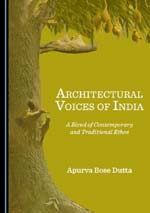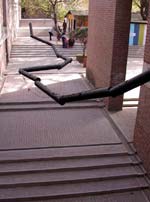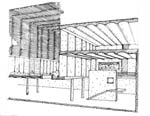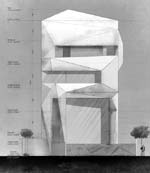
|

|
|
Home Site Search Contact Us Subscribe
|
|
Apurva Bose Dutta: "Architectural Voices of India: A Blend of Contemporary and Traditional Ethos" The architectural journalist talks about how and why her first book came together, and highlights some of the thoughtful voices she encountered. By Apurva Bose Dutta October 12, 2017 Editor’s note: For the month of October, U.K.-based Cambridge Scholars Publishing is offering an exclusive 50% discount. Click here for details.
Indian and global architecture has frequently been represented, deliberated, and discussed by architects across different platforms. While the voice of architects from the West has been emphatically heard, there seldom has been a platform where a combined voice of architects from India has emerged to not only talk about their distinctive journeys in architecture, but to also throw light on the subject and the profession in India and globally. Architectural Voices of India: A Blend of Contemporary and Traditional Ethos (Cambridge Scholars Publishing, August 2017) bridges this gap between the architects, built environment, and the common man, and brings out the voices of 17 iconic architects from India. These architects across generations probe into core issues and offer their perspectives through conversations. While the book celebrates the diversity in Indian architects and their architecture, it is also an ode to the unique thread that binds the entire fraternity and motivates them to build for a common cause.
Architectural Voices of India brings to the forefront the architects’ unique and inspirational journeys, their varied design philosophies and building typologies, the evolution of architecture, reflections on the new role that architects should play, and the state of the profession. It is no secret that Indian architecture has been in a wonderful state of exploration, with many architects throughout the country boldly accepting the challenge to create something atypical. The book, in many ways, also honors these “creators” who make it all happen in a field that is an integral part of building a nation; there are takeaways for all, including industry professionals, students, and general readers.
While the focus is on conversations, the well-illustrated book also presents images, drawings, and sketches of the architects’ seminal projects, offering a sneak-peek into their informal spaces and into projects that led to many redefinitions for them. The range of architects covered is fascinating – from the legendary BV Doshi, Raj Rewal, and Shiv Dutt Sharma, to the contemporary Manit-Sonali Rastogi, Kamal Malik, and Sanjay Puri; from the sustainability experts Nimish Patel-Parul Zaveri and Sanjay Mohe, to the urban planner Christopher Benninger; from the skyline expert Hafeez Contractor to the conservationist Brinda Somaya, and many more of India’s illustrious architects. The foreword is by Dr. Vikramāditya Prakāsh, a professor of architecture at the University of Washington, Seattle, a well-known academician from India but based in the U.S. for the past many years.
Here is a selection of interesting statements made by some of the architects featured in the book:
Christopher Charles Benninger, CCBA Designs, Pune: “I feel Indian architects have recently come to grips with the fact that there has been a gap in our history. There have been lost periods during the early invasions, colonial times, after Independence, and now with globalization. These times saw traumatic disruptions in our cultural continuity. Suddenly, India finds that it is the oldest civilization in the world and, simultaneously, the newest society. We have had to reinvent ourselves suddenly.” (Chapter 1: In Pursuit of Nirvana)
Hafeez Contractor, Architect Hafeez Contractor, Mumbai: “To be honest, one’s passion changes with time. There was a time when all I wanted to do was work; money was not that important. The passion for work remains. However, when I heard someone comment that I was a fool who would work for free, something in me changed. I realized that people were judging me on the basis of the amount of money I had.” (Chapter 3: On a Different Altitude) (Chapter 4: Celebrating the Life in Architecture)
Karan Grover, Karan Grover & Associates, Vadodara: “I am now beginning to question the green rating systems. I feel that rating systems are not important; what is important is to set standards. Earlier, ratings had a role to play that was unfortunately abused and misused – by architects as well as clients. It became more of a competitive trend to determine ‘who has designed a larger number of green buildings.’ There was hardly anyone who was talking about the idea of sustainability anymore.” (Chapter 5: The Crusader)
Parul Zaveri & Nimish Patel, Abhikram, Ahmedabad: “In the early 20th century, the designers of buildings became more important than the people who got the projects initiated and completed, or the purpose for which the buildings were made. Today, we don't know who should be the role models for our inspiration. Can it only be Le Corbusier, Zaha Hadid, Frank Gehry, Charles Correa, or BV Doshi, or can they also be the unknown sthapaties and craftspersons who designed most of India’s built environment?” (Chapter 10: Responsible Architecture)
Sanjay Puri, Sanjay Puri Architects, Mumbai: “The biggest strength of Indian architecture stems from the growing economy, as an outcome of which the extent of architectural work available has grown dramatically. The population and the kind of housing needs in India are enormous. The next 20 years will see much more built architecture than what has been seen in the past 40 years. There will be a huge amount of work, which will create many opportunities.” (Chapter 11: Treading the Untrodden Path)
Sonali & Manit Rastogi, Morphogenesis, New Delhi: “Indian architects are amongst the best in the world; they need to realize the potential that they possess and rise to the challenges confronting the profession today by presenting a vision of what we can be, not only what we are or have been.” (Chapter 13: Defining Contemporary Indian Architecture)
Raj Rewal, Raj Rewal Associates, New Delhi: “The general situation of architecture in India is messy and chaotic. Too many things are happening very quickly, so the quality of architecture tends to suffer. But, at the same time, one can do very good work in chaos without anyone knowing about it; that is maybe the advantage of working in India.” (Chapter 14: Pure Architecture)
Completing the roster of featured architects:
Ravindra Bhan, Ravindra Bhan & Associates, New Delhi (Chapter 2: Building with (in) Nature) Sandeep Khosla, Khosla Associates, Bengaluru (Chapter 6: Romanticism in Architecture) Kamal S Malik, Malik Architecture, Mumbai (Chapter 7: Spiritual and Progressive) Sanjay Mohe, Mindspace, Bengaluru (Chapter 8: Spatial Dynamics) Prem Nath, Prem Nath & Associates, Mumbai (Chapter 9: Resourceful Architecture) CN Raghavendran, M/s CR Narayana Rao, Chennai (Chapter 12: Intellectual Designing) Jasbir Sawhney, Jasbir Sawhney & Associates, New Delhi (Chapter 15: Rationality in Architecture) Shiv Datt Sharma, SD Sharma and Associates, Chandigarh (Chapter 16: Concretizing Architecture) Brinda Somaya, Somaya & Kalappa Consultants, Mumbai (Chapter 17: Curative Architecture)
About the author:
Apurva Bose Dutta is an award-winning architectural journalist from India. She is an alumnus of the Chandigarh College of Architecture (B.Arch, 2005), but chose to tread a lesser-known path and pursued architectural journalism as her primary profession. With a diploma in freelance journalism from the U.K., Apurva has spent the past 12 years writing about the A/E/C industry, bringing every aspect to the forefront. While she is working towards making architectural journalism a mainstream profession in India through her various initiatives, she also wants to highlight journalism as THE medium to talk about, critique, and create a demand for better architecture for society. Having won three awards for her journalistic work, she is constantly exploring avenues to communicate about architecture globally. She can be reached at apurvabose@yahoo.com
|
(click on pictures to enlarge)  Cambridge Scholars Publishing “Architectural Voices of India: A Blend of Contemporary and Traditional Ethos” by Apurva Bose Dutta  Apurva Bose Dutta B.V. Doshi: Centre for Environmental Planning and Technology (CEPT), Ahmedabad  Courtesy The India House Art Gallery Christopher Benninger: Sketch of the India House, Pune  Courtesy Architect Hafeez Contractor Hafeez Contractor: Infosys-BPO and ECC Block, Pune  Courtesy Karan Grover & Associates Karan Grover & Associates: Proposal for the Living Heritage Centre, Navi Mumbai  Courtesy Abhikram Parul Zaveri & Nimish Patel: Torrent Research Centre, Ahmedabad  Courtesy Sanjay Puri Architects Sanjay Puri: Front Elevation of the Origami House, Pune  Photo by Ajay Rajgarhia; courtesy Morphogenesis Sonali & Manit Rastogi: ITC Park Boulevard (Fortune) - a boutique hotel, New Delhi  Courtesy Architectural Research Cell, Raj Rewal Associates Raj Rewal: Overview of the Jang-E-Azadi Complex, Kartarpur (under construction) |
© 2017 ArchNewsNow.com